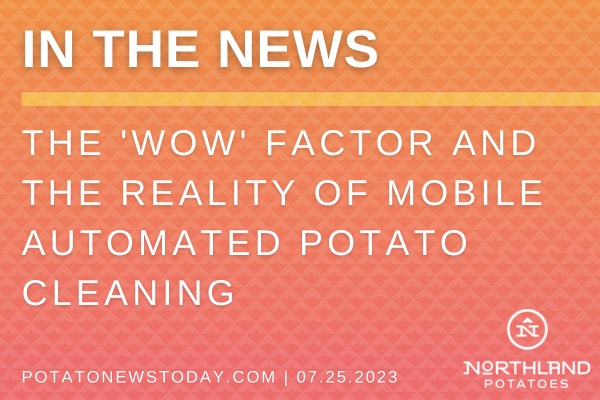
The ‘wow’ factor and the reality of mobile, automated potato cleaning
If you’re convinced the only way your potato field can, year after year, produce so many rocks is that they must be reproducing underground, you’re not alone. Harvesting rock and debris alongside one’s potatoes is a frustrating and expensive reality of production.
Until recently, producers haven’t had good post-harvest handling options. Operating a picking line is costly, inefficient and, as fewer and fewer people are willing to take on menial piece-work, increasingly challenging to staff. Shipping direct from field to processor without cleaning means hefty penalties imposed on debris. Cleaning in the yard means paying to move tare from field to yard and back again; storing without cleaning means paying to store dirt, rocks and vines, not to mention an increased likelihood of bruising, nicking, skinning and/or heating and rot.
There is, however, a better way.
In the past ten years, several companies have come forward with various versions of fully or nearly fully automated potato cleaning lines. Rather than depending heavily on human labor, the lines use a series of conveyor belts, vibrating tables and air pressure to separate harvest from debris. While both positive air (blowing) and negative air (vacuum pressure) versions are available, negative air technology is less dusty and — just as it is easier to clean a house by vacuuming than by blowing dirt out one’s door — more effective.
In just the past two years, automated potato cleaning lines have made one new and enormous step forward: full mobility. Contained on a single semi-trailer that can be moved between locations at highway speed, today’s diesel powered, telescoping units can be set up and operational right in one’s field in as little as 30 minutes. Showing these units off at industry tradeshows is a ton of fun; growers are so wowed by the mobile technology that the most common comment I’ve heard is: “I wouldn’t have believed it if I wasn’t actually seeing it!”
Separating rocks and debris from clean dirt right in the field offers multiple benefits. In addition to cost savings and enhanced efficiency, sieving out the garbage on-site allows a producer to increase the fertility of a field for future years, potentially opening up marginal land. It also means today’s producer has the option to plant potatoes following a corn rotation since root balls are no longer a concern.
Given that automated potato cleaning lines can handle 3500 to 5000 sacks per hour, they tend to best suit large operations. Return on investment varies largely based on the volume of product going across the conveyors and how much debris needs to be separated from one’s tubers. Some farmers who implement this technology report decreasing their picking lines from 35 or 40 people to just three or four. In a case like that, labor savings alone could pay off the machinery in just a couple years.
Today’s farm consolidation, per acre production increases and tight labor market mean maximizing efficiency is more vital to farm business success than ever before. Mobile, automated potato cleaning lines are just one of many new efficiency-focused innovations coming soon to a field near you.
Source: Lockwood Manufacturing
Photo: The Lockwood Vacs Mobile. Credit Lockwood Engineering
From potatonewstoday.com. Read here.

